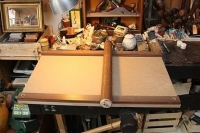
However, after those experimentations had failed, we began to move the smartphone away from the magnifying glass. Of course, understanding now how the science of this works, that was not the smartest idea. We started by moving it closer to the magnifying glass, at 8 cm, then 6 cm, 4 cm, and finally right up against it. It was originally sitting towards the middle of the projector, about 11 cm away from the magnifying glass. Finally, we thought to move the location of the smartphone. We first took our chances with the magnifying glass, flipping it inside out, turning it around, but alas, there was no result. That was when we realized that it probably had to do with projector itself. We moved into a smaller, darker room – almost pitch black – but the image would still not appear. So then we attempted to change a few things, starting with the environment. We could not understand why the image would not project. Looking into the projector through the magnifying glass, we could see the clear image of the screen - slightly magnified with an enhanced feel. At first, all we could see was a white glow beaming on to the wall. We had placed the smartphone into projection box, and essentially aimed it towards the wall.

Our first substantial issue came up while initially attempting to use the projector. With both problems solved, our magnifying glass was finally secured into place, ready for use. We solved this issue by creating a small stand in the inside of the box with left over cardboard to support the magnify glass. The second minor issue we encountered in the process was trying to make the magnify glass stay on the same level as the hole we created. This was easily fixed by adding duct tape to the spaces, thickening the frame around the magnifying glass and essentially securing the hold. However, this gave way to another issue, leaving some holes around the magnifying glass where light can go through. To solve this minor issue, we used the knife to trim the sides slightly. After we cut the circle out however, we noticed that it was a tad too small for the magnifying glass to fit - through several attempts of squishing it in. To create the hole, we traced in the inside loop of the duct tape to draw a circle slightly smaller than that of the magnifying glass. The initial minor issue that we encountered was the making of the hole in the box (in order to place the magnify glass in it). Luckily for us, a few were minor issues that were solved in good time. Like all great inventors, we ran into several obstacles while creating the smartphone projector. All of the kinks were worked out, and we were very happy with our final product. By getting the camera to use a longer exposure, it was able to let in more light (and unfortunately produce a little more of a blurrier photo) and therefore capture our image on the wall better! Now, finally we were done.
#Homemade projector manual#
We were told to go into the manual setting of our said camera, and change the exposure length (basically how long the camera takes to take the picture). Finally, we decided to go to our trusty TA for help during our tutorial. We then tried to use flash, which turned out to be a very bad idea as the projection did not appear at all.


All of the ones we attempted to take turned out very dark, and unclear. We realized that we could not take a proper photo of the image on the wall. Quickly, we ran into our final issue - although unrelated to the projector itself, but rather the documentation of our work. After various test trials of seeing what distance (from the box to the wall) would project the clearest image, we found that holding the box approximately a meters length away worked best! Ecstatic with our final project, we decided to take a photo of the image on the wall. We quickly came to terms with this, and were regardless happy with our results. Unfortunately, we weren’t able to configure the iPhone settings ourselves to properly address and prevent the minor issue. Otherwise, the projector would project the mirrored image, where any writing would appear backwards. We know that we could configure a setting on the iPhone that would mirror the original image, and therefore while being projected we would see the original image. The image was upright, however it was backwards.

The issue we ran into next however, was a little more puzzling. Otherwise, the image reflected would be upside down. At last! We had finally figured out all of the kinks in making our projector to work! We were successfully able to project the image on the smartphone onto the wall and view videos and photos. We quickly realized that due to the light refracting the way it did through the magnifying glass lens, we had to flip the image on the phone for it to properly project against the wall. Initially, we physically flipped the phone, so that it sat upside down, so that the image was upright.


 0 kommentar(er)
0 kommentar(er)
